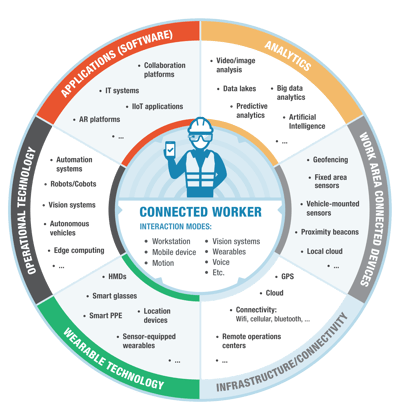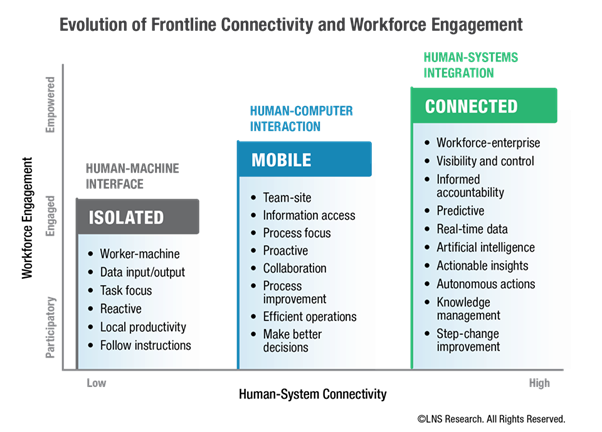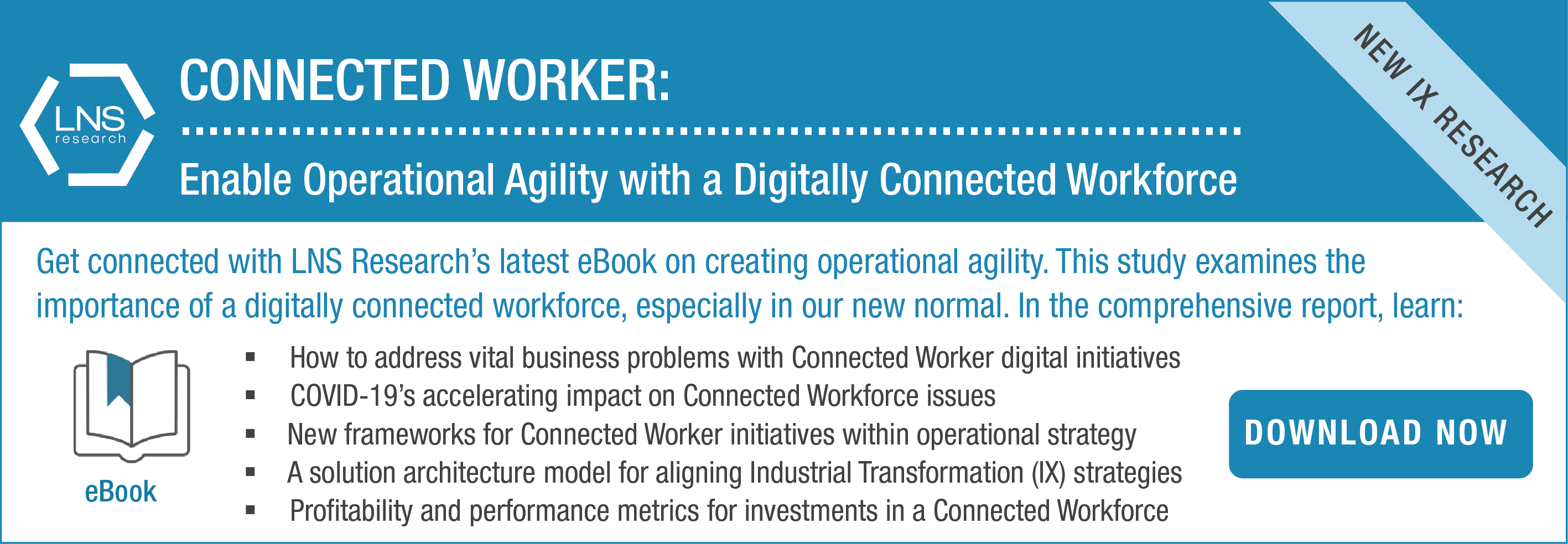It’s been nearly three years since LNS Research initiated coverage of the digitally connected industrial worker space with the publication of our seminal research, “The Connected Worker: Mobilize and Empower People to Reduce Risk and Improve Safety”. Since then, we’ve continued to conduct research and develop our point of view on the topic while working closely with a variety of industrial organizations and technology vendors on their connected worker initiatives and solutions.
The past few years have seen tremendous growth and rapid change in connected worker solution technologies and market adoption. Key drivers of this evolution have been the Industrial Transformation (IX) macro trend, and the COVID-19 pandemic. Given the market dynamics, as well as our most recent research findings, we’ve stepped back to re-assess and refine our definition of the space and the vendor landscape to be most useful for industrial companies to frame their initiatives.
What are Connected Frontline Workforce Applications?
We’ve honed the focus of our research coverage in the past three years from the broad topic of “Connected Worker” to the sub-set “Connected Frontline Workforce Applications” (referred to as CFW apps). This was done with the goal of providing a sharp focus on what we think is the core enabler of a digitally connected workforce. Let’s break down the CFW apps terminology:
- Connected- use of digital technologies to increase the flow of data, information, insights, and actions throughout operations.
- Frontline - where work is done in core industrial operations, most notably production and maintenance.
- Workforce - the people performing work on the frontlines, including production and maintenance personnel.
- Applications - the technology backbone needed to manage data and content, enable workflow and execute processes, and provide insights to improve performance.
LNS Research defines the CFW apps category as software applications designed for and used by the frontline industrial workforce to enable the multi-directional flow of context-relevant data, digital content, information, insights, and actions throughout the operational management system, including people, assets, technology systems, and the work environment. CFW apps make innovative use of digital technologies to extend the functionality of conventional mobile applications to increase the circulation of accurate, timely information to, from, and among frontline workers. This enables better, faster decisions throughout the organization; real-time feedback and actions; improved communication and collaboration; increased workforce engagement; and actionable insights at all organizational levels for systematic improvement of how work is done to benefit productivity, safety, and quality.
CFW apps make innovative use of digital technologies to extend the functionality of conventional mobile applications to increase the circulation of accurate, timely information to, from, and among frontline workers. This enables better, faster decisions throughout the organization; real-time feedback and actions; improved communication and collaboration; increased workforce engagement; and actionable insights at all organizational levels for systematic improvement of how work is done to benefit productivity, safety, and quality.
The term “connected worker” is often equated with wearable technologies like smart glasses or body-worn devices that collect data. Although this is partially true, such tech is only part of a total solution. In our CFW apps definition, the focus is on software applications per se. Realizing the value of digitally connecting people is only possible with software-enabled capabilities: workflow; data and content management; process execution; and analytics. Smart connected devices and hardware are certainly vital to capture and deliver information to people, send signals, and trigger actions, but software applications are the backbone of an intelligent solution with strategic value.
Who Uses CFW Apps and for What?
CFW Applications can be used by any industrial organization to level up operational performance by helping to increase productivity, better manage safety risks, and improve product and service quality. Industry sectors fitting with our category definition and most likely to benefit from adoption are manufacturing (discrete, process, and batch/hybrid), energy, and infrastructure. Early adoption has been greater in discrete manufacturing with other sectors catching up quickly.
Frontline workers are the main direct beneficial users, with CFW apps deployments potentially scaling to many thousands of users in a large enterprise. The benefits of increased transparency and better execution can also roll up to all organizational levels, especially team leaders, operations and functional managers, and executives.
CFW apps are usually deployed to the frontlines on either hand-held mobile devices, such as smartphones and tablets, or head-mounted displays, such as smart glasses or helmet-mounted displays. The User Experience (UX) and digital content may be enhanced with Augmented Reality (AR) capabilities. Some common cross-functional use cases are: the provision of digital work instructions/SOPs; remote expert assistance, including live communication with digital content including voice and video; in-context/micro training; and inspections/audits.
Use case applications span core value chain processes, so Production and Maintenance personnel are most often at the heart of CWF apps deployments with Quality, EHS, Supply Chain, Plant Engineering, and Field Service also being frequent participants. From a functional perspective, the most common use cases include production/assembly, complex asset maintenance, quality inspections, and a variety of EHS-related use cases. CFW initiatives might start with pilots and projects in any of these areas and expand from there.
Basic Characteristics of a CFW App Offering
Our advice to an industrial organization contemplating an initiative to digitally connect the frontline workforce is to start by clearly identifying specific business problems to be solved, then conducting solution selection accordingly. This means avoiding the temptation to focus on tech testing and evaluation per se. There are thousands of connected worker technologies on the market ranging from sensors and beacons to comprehensive application platforms. Only some are CFW apps. The following high-level characteristics provide a good basis for developing an initial list of candidates.
- Commercial Product- commercially available, licensable software-based product for use by the industrial frontline workforce including but not limited to production and maintenance users.
- Industrial Focus- vendor has dedicated go-to-market focus on and presence in industrial sectors, especially Manufacturing (discrete, process, batch/hybrid), Energy, and Infrastructure.
- Solution-driven- proven capability to provide customers a complete solution to deliver on vendor’s value proposition. Solutions may be delivered through in-house product and service offerings, complemented by established partnerships.
- Multiple Use Cases- functionality to support a broad range of cross-functional use cases across operational domains such as production, quality, maintenance, EHS, supply chain, and field service. Capability to flexibly meet new and changing use case requirements is essential.
- Digital Tech- incorporates connected operations digital technologies, such as: Artificial Intelligence (AI), Machine Learning(ML), Industrial Internet of Things (IIoT), and Augmented/Virtual Reality (AR/VR) among many others; runs on private or public cloud instances; and supports hybrid/edge cloud architectures.

Key Capabilities
Supplementing the five basic characteristics described above, LNS Research has identified essential capabilities for a Connected Frontline Workforce offering to deliver scalable enterprise value. This doesn’t mean that there are any “one-size-fits-all” solutions; CFW solutions vary widely in terms of type and range of key capabilities. However, we have identified a range of synergistic key capabilities that can maximize the potential for successful wide-scale enterprise deployment and value.
- Connectivity - enable digital connectivity of workers to, and among, multiple elements of the operational management system, including people, assets, IT and OT systems, and the work environment.
- Flexibility - native capabilities to adapt to changing use case requirements, such as workflow authoring and orchestration, configurability, and extensibility, preferably with no-code/low-code development.
- In-context content - provision of context-relevant information/content to users at the point of work, including digital work instructions/procedures and other digital content, e.g., video, audio.
- Integration - embedded capability to connect to and share data with a variety of data sources, including Information Technology (IT) and Operational Technology (OT) systems (e.g., APIs, connectors, etc.)
- IIoT support - collect and manage sensor-generated and edge device data, e.g., from wearables, fixed assets, work area monitors, vehicles, etc.
- Analytics - embedded reporting and analytics including Business Intelligence capabilities, management dashboards, and performance reporting. May include advanced analytics, e.g., AI/ML.
- Ecosystem - established partnerships as needed to enable a complete solution for customer value delivery.
Moving Forward
Industrial organizations continue to embrace Connected Frontline Workforce initiatives as a core pillar of their IX programs and are accelerating them in the wake of the COVID-19 crisis. Frontline workforce issues are among the top strategic priorities in industrial operations, specifically addressing a severe talent shortage, and ensuring a safe and healthy workplace. Initiatives based on CFW apps are increasingly being used to enable the operational agility needed to address these business problems through a competent, safe, and engaged workforce.
LNS Research will be publishing more research related to the CFW initiatives throughout 2021. In the meantime, for those starting or accelerating such initiatives, we recommend placing a priority on incorporating these efforts into the overall IX program, having a laser-like focus on solving business problems, and getting buy-in from the frontline workforce who will be most directly impacted. As with any transformation initiative, it will be strategy, cultural readiness, and effective change management that will determine success more so than technology selection.
